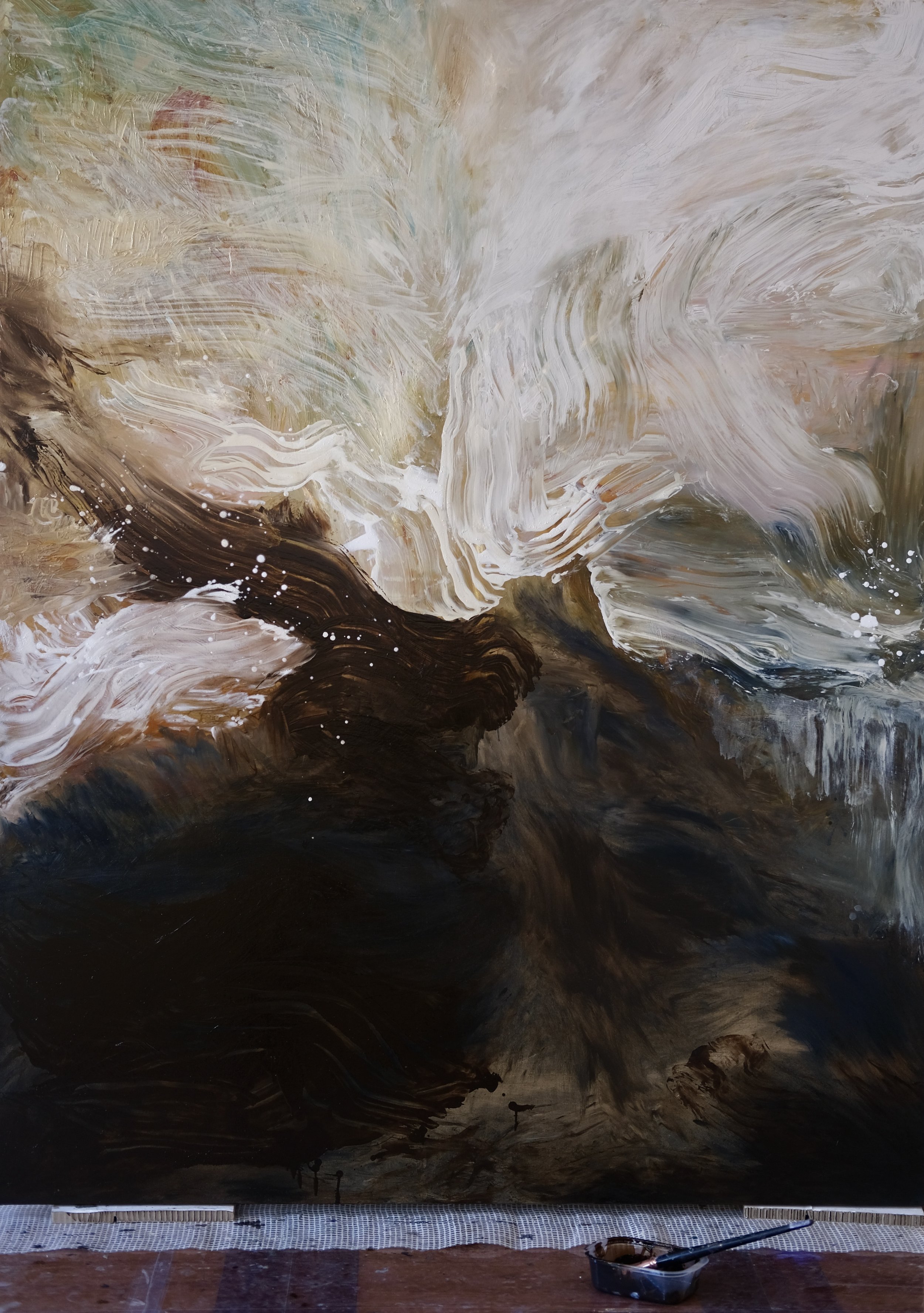FR
Le sixième chapitre s’écrit aux sons de la Terre.
Le paysage se forme sous nos yeux, non selon une logique géographique, mais selon les mouvements secrets d’une mémoire tellurique. La matière picturale s’impose ici comme une force — fluide, instable, vivante.
On y perçoit des courants invisibles, des mouvements souterrains, des glissements. La peinture ne cherche pas à figurer un paysage, mais à en capter l’état, son instabilité organique, sa part fuyante.
Chaque toile devient un terrain de fouille sensible, où la lumière jaillit non pour éclairer, mais pour révéler — ou pour brûler. Elle surgit comme un souffle, une tension vive entre ombre et éclat, oubli et réminiscence.
Ce travail s’inscrit, sans le revendiquer, dans la lignée d’un romantisme revisité. Comme chez les photographes du XIXe siècle — Macpherson et Le Gray — le regard ne cherche pas à documenter, mais à transcender. Ce n’est pas la nature que l’on montre, mais ce que la nature nous fait sentir : sa puissance, son indifférence, sa beauté vertigineuse. Il y a dans cette matière une quête du sublime, non comme grandeur spectaculaire, mais comme expérience intérieure du vertige. Ce moment de bascule où l’on se trouve face à une force qui nous dépasse, à la fois fascinante et insaisissable.
La peinture devient un lieu d’épreuve : la lumière y est à la fois révélation et ruine et le sombre n’est pas obscurité, mais profondeur.
Les formats verticaux évoquent des chutes, des élévations incertaines, des tensions soulevées par une force vitale. Parfois, les œuvres se répondent — fragments de récit sans début ni fin. Une sorte de cadavre exquis géologique où chaque panneau prolonge ou contredit le précédent. Il n’y a pas de centre, pas de réponse : seulement le flux.
Il s’agit peut-être d’une mémoire qui ne serait pas celle des hommes, mais celle du monde lui-même.
ENG
The sixth chapter is written to the sounds of the Earth.
The landscape takes shape before our eyes, not according to a geographical logic, but according to the secret movements of a telluric memory. Here, pictorial matter asserts itself as a force - fluid, unstable, alive.
We perceive invisible currents, subterranean movements and displacements. The painter's aim is not to depict a landscape, but to capture its state, its organic instability, its elusiveness.
Each canvas becomes a sensitive terrain of excavation, where light emerges not to illuminate but to reveal - or to burn. It emerges like a breath, a living tension between shadow and radiance, oblivion and memory.
This work is in the tradition of Romanticism revisited, without intending to be. As with the 19th century photographers Macpherson and Le Gray, the aim is not to document but to transcend. We don't show nature, but what nature makes us feel: its power, its indifference, its dizzying beauty. There is a search for the sublime in this material, not as spectacular grandeur, but as an inner experience of vertigo. It's that tipping point where we come face to face with a force that transcends us, at once fascinating and elusive.
Painting becomes an ordeal: light is both revelation and ruin, and darkness is not obscurity but depth.
Vertical formats evoke falls, uncertain elevations, tensions created by a vital force. Sometimes the works respond to each other - fragments of a narrative without beginning or end. A kind of geological exquisite cadaver in which each panel extends or contradicts the previous one.
Maybe it's not about memory, but about the world itself.
IT
Il sesto capitolo è scritto ai suoni della Terra.
Il paesaggio prende forma davanti ai nostri occhi, non secondo una logica geografica, ma secondo i movimenti segreti di una memoria tellurica. La materia pittorica si impone come una forza, fluida, instabile, viva.
Percepiamo correnti invisibili, movimenti sotterranei, spostamenti. La pittura non cerca di rappresentare un paesaggio, ma di catturare il suo stato, la sua instabilità organica, la sua inafferrabilità.
Ogni tela diventa un terreno sensibile di scavo, dove la luce si sprigiona non per illuminare, ma per rivelare - o per bruciare. Emerge come un respiro, una tensione vivace tra ombra e brillantezza, oblio e reminiscenza.
Questo lavoro si inserisce nella tradizione di un romanticismo rivisitato, senza l'intenzione di esserlo. Come nel caso dei fotografi del XIX secolo Macpherson e Le Gray, l'obiettivo non è documentare, ma trascendere. Non si tratta di mostrare la natura, ma di trasmettere ciò che la natura suscita in noi: il suo potere, la sua indifferenza, la sua vertiginosa bellezza. In questo materiale c'è una ricerca del sublime, non inteso come grandezza spettacolare, ma come esperienza interiore di vertigine. È il punto di svolta in cui ci troviamo di fronte a una forza che ci supera, affascinante e sfuggente.
La pittura diventa un luogo di prova: la luce è allo stesso tempo rivelazione e rovina, e il buio non è oscurità, ma profondità.
I formati verticali evocano cadute, incerte risalite e tensioni sollevate da una forza vitale. A volte, le opere dialogano tra loro - frammenti di una narrazione senza inizio né fine. Una sorta di “cadavre exquis” geologico, dove ogni pannello si prolunga o contraddice il precedente. Non c'è centro, non c'è risposta: solo flusso.
Forse si tratta di una memoria che non appartiene all'uomo, ma al mondo stesso.
I, 2025, 198x153 cm, Oil on canvas
II, 2025, 198x153 cm, Oil on canvas
III, 2025, 198x153 cm, Oil on canvas
IV, 2025, 198x153 cm, Oil on canvas
II- 2025 - 198x153cm - Oil on linen canvas
I- 2025 - 198x153cm - Oil on linen canvas
III- 2025 - 198x153cm - Oil on linen canvas
IV- 2025 - 198x153cm - Oil on linen canvas
II- 2025 - 198x153cm - Oil on linen canvas
Vidéo 0,45 mn - Lighthouse Melagavi, Loutraki Perachoras, Peloponnisos, Grèce.




